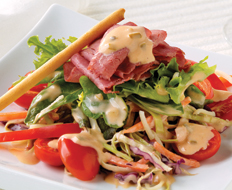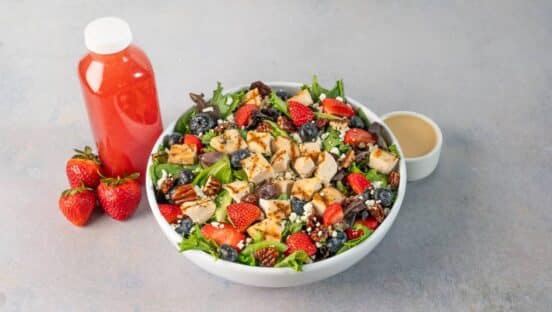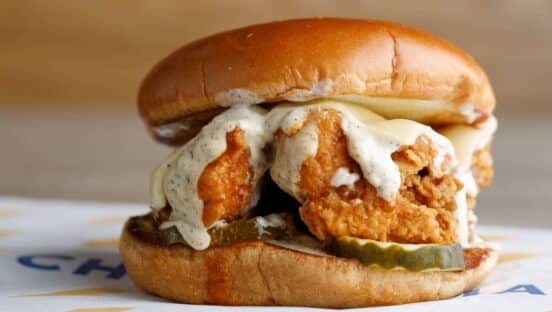Not that long ago, consumers visited limited-service restaurants mostly for items such as burgers, fried chicken, french fries, and sandwiches. But in the past two decades, salads have become an integral part of quick-service and fast-casual menus, now showcased as a prominent entrée on many restaurants’ menuboards.
“The great story of the last 20 years is that salads moved to the center of the plate,” says Paul Steck, president of Philadelphia-based Saladworks, the nation’s largest salad chain with more than 100 units in 11 states.
Among 240 limited-service companies that Technomic includes in its Top 500 restaurant chains, 60 percent offered entrée salads during last year’s third quarter. Some 86 percent of fast-casual chains had these dishes on their menus, too.
Overall, the number of entrée salads at quick-service and fast-casual restaurants rose 12 percent from 2009 to 2012, the Chicago-based research and consulting firm reports. This growth comes amid rising consumer demand, particularly by women, for lighter, healthier menu items.
More than four of every five American adults bought salads away from home at least occasionally during 2011, Technomic reports. Nearly half of consumers say they order salads on most restaurant visits, up from 34 percent two years earlier.
As salads have increased in popularity, the variety of dressings served with them has expanded, as have the types of vegetables, fruits, and nuts that act as toppings.
“Dressings and toppings are where the flavor comes from,” says Kelly Weikel, senior consumer research manager for Technomic. “People don’t want to veer much from their health needs, but they definitely still want to indulge when they eat out.”
In the past, healthy meant flavorless, says A. Michael Toroyan, chief operating officer at Tossed, which has seven locations across the country. “So we’re focused on great-tasting, healthy products, without being sinful from a calorie standpoint.”
Operators’ improving ability to source top-quality ingredients and offer a wide range of salad options has influenced chains like Corner Bakery. During the past decade, the company’s salad sales share jumped from single digits to more than 20 percent.
“Every time we made a decision to expand the category, sales grew,” says Ric Scicchitano, senior vice president of food and beverage at the Dallas-based bakery-café chain, which uses upward of 40 types of produce every day.
Vinaigrette dressings are becoming popular as menu developers balance health and taste. While most dressings had fewer menu mentions in the third quarter of 2012 compared with a year earlier, vinaigrette mentions jumped from 12.2 percent to 14.8 percent, according to Technomic. Vinaigrettes are viewed as healthier options than traditional creamy dressings because they are generally lower in calories and fat but high in flavor, Weikel says.
Another growing dressing ingredient is extra virgin olive oil, says Ryan Baxter, senior executive research and development chef for Kraft Foodservice, part of the well-known Kraft family of food companies.
“We’re seeing it increase in popularity, with the inclusion of extra virgin olive oil in the name [of the dressing],” he says. “That brings a level of wholesomeness and quality consumers are looking for.”
Although dressings serve as the “flavor backbone” of salads, companies like Sweetgreen “believe in letting fresh, organic ingredients speak for themselves,” says Nic Jammet, cofounder of the 13-unit salad and organic frozen-yogurt chain.
The growing Washington, D.C.–based company has a specific approach to all of its ingredients, including the dressings made daily at each restaurant: Keep it simple. Jammet says companies can be creative without being overly complex when it comes to salads.
Sweetgreen prefers light dressings to allow other ingredients to shine. Of the 17 dressings available in the chain’s signature or make-your-own salads, about a dozen are vinaigrettes. The few creamy dressings are made with yogurt to make them healthier.
All of the dressings, most of them vinaigrettes, at Los Angeles–based Tender Greens are designed specifically for each of the $11 “big” salads. Erik Oberholtzer, chef and co-owner of Tender Greens, says the eight-unit chain’s ingredients, including the daily-made dressings, are “given a tremendous amount of thought.” As a result, there are no make-your-own options.
For a steak salad on the menu, Oberholtzer wanted as light a horseradish dressing as possible. He came up with one that contains champagne vinegar, crème fraîche, canola oil, salt, and pepper. “It goes very well with steak and beets,” he says.
Major quick-service restaurants have noticed the rising popularity of innovative dressings. Wendy’s, a leader in the fast-food salads-as-entrées movement, offers several vinaigrettes, including one with pomegranate juice, balsamic and white wine vinegars, orange zest, shallots, and spices.
“In the past 10 years, vinaigrettes have become more popular,” says Lori Estrada, vice president of culinary development for the Columbus, Ohio–based company. “It’s not just the vibrantness of the dressing … but the cleanness of it.”
The pomegranate vinaigrette is part of Estrada’s favorite salad, the Apple Pecan salad, which also has dried cranberries and Blue cheese crumbles. “It has a lot of flavor, color, and texture,” she says, adding that it could be overwhelmed by a heavy dressing.
Wendy’s develops its dressings, which are then produced and packaged in individual servings by a private manufacturer. Although some small restaurant companies are able to continue making dressings daily in their stores, consistency becomes more difficult to maintain as a chain grows.
“All of our dressings, until six years ago, were made in the stores,” Saladworks’s Steck says. “As we hit 70 units, we started seeing huge differences in the dressings from one store to the next. It was the same recipe, but was different depending on who made it.”
Even a smaller company, such as Tossed, needs to have its dressings produced in one location, because its units are in cities all across the country. “You really need to have a consistency of your product,” Toroyan adds.
Not all restaurants use dressings they design. McDonald’s premium salads are served with existing varieties of Newman’s Own dressings that are formulated for restaurants.
[pagebreak]
Traditional dressings still rule the roost at many quick-serve chains. Ranch varieties show up in 12.9 percent of limited-service salads, according to Technomic, and long-time favorites Caesar, Blue Cheese, and Thousand Island are also near the top.
“There’s little aversion to risk,” says Kraft’s Baxter, whose company provides nearly 40 different groups of dressings to all types of eateries across the country. Most dressings include low-fat and fat-free versions.
“A lot of decisions about the dressings on the menu are driven by marketing, which says we need to have a Caesar, a French, an Italian, a fill-in-the-blank,” he says. “There is room on the menu for maybe one or two out-there dressings that are less familiar.”
When restaurants add nontraditional dressings, they are often ethnically inspired options; increasingly popular are Hispanic dressings, which might include chipotle and cilantro, and Asian dressings, featuring ginger or sesame oil. These often “have less calories but pack a lot of flavor,” Steck says.
Various salsas are used as a salad ingredient, but the citrus salsa served with Taco Bell’s taco salads is different because the thick, chunky condiment is also the dressing.
“It adds a level of flavor and a level of freshness a creamy dressing can’t provide,” says Heather Mottershaw, a director with the chain’s Food Innovation Team.
The salsa is being redeveloped with the assistance of chef Lorena Garcia, who reviewed all of Taco Bell’s menu items and worked with the company to create its more upscale Cantina Bell creations.
“We looked at the citrus salsa and asked, Is this the best it can be?” Mottershaw says. The new version is “really upping” the quality with more flavorful ingredients, she says, including fire-roasted tomatoes and fire-roasted garlic.
While dressings carry a large portion of the flavor in limited-service salads, there are plenty of other non-protein ingredients that add to the taste. Among the most popular, according to Technomic, are tomatoes, cucumbers, croutons, onions, carrots, and olives.
Just don’t refer to them as toppings, Tender Greens’ Oberholtzer says.
“Calling them toppings sends a message that you’re just sprinkling stuff on top of greens,” he says. “Here, the ingredients are components.”
The ability to source fresh, often organic produce year-round has been a boon for salad chains. Tender Greens’ online menus mention the farm or artisan for each ingredient.
Sweetgreen also “gets excited about local produce,” Jammet says. “We have a great, national organic partner that gives us a source for produce throughout the year.”
Sweetgreen salads start at $6.95 and go up to $11. One of the most popular is the Guacamole Greens Salad, which includes a range of greens, avocado, grape tomatoes, red onions, and crushed tortilla chips topped with lime cilantro jalapeño vinaigrette and a lime squeeze. “It all works very well together,” Jammet says.
Avocado is the key ingredient in many other popular salads at various restaurants. Among limited-service companies, the fruit is the fastest-growing produce ingredient, showing up in 4.8 percent of salads last year, up from 3.3 percent in 2011.
“People love it,” Scicchitano says. It is also a superfood rich in monosaturated fat, which assists blood flow. That offsets the downside of its high calorie level.
Avocados are part of Corner Bakery’s top salad, the Chopped Salad, and are also in the chain’s popular Anaheim Scrambler breakfast and Anaheim Panini.
“It used to be you could only get avocados out of California,” Scicchitano says. “Now, they can be from Mexico or South America, like Peru, and so they are available all year round.”
Tossed’s top salad, the Southwest Blackened Chicken Salad, also has avocados, along with blackened chicken, Feta, a black bean corn salsa, chopped tomatoes, tortilla strips, and a citrus-chipotle dressing.
Corn and black beans are two more of the top emerging salad ingredients, as are garlic, Gorgonzola, scallions, apples, and dried cranberries, Technomic says.
The most popular salad nuts are walnuts, which are rich in flavor as well as omega-3 fatty acids, antioxidants, vitamin E, and other nutrients. The nuts go particularly well with apples, and that’s why several restaurant chains, including Tossed, feature
apple-walnut salads.
“Walnuts are incredibly versatile, and they work with so many other ingredients,” says chef, author, and TV cooking-show host Joanne Weir. “Lots of vegetables, as well as fruits, go well with them. That’s why they do so well in salads.”
The classic Gorgonzola and walnut salad—often including roasted beets—is a popular choice among chefs, as is a simple spinach salad with walnuts.
“There is a slight bitterness to the [walnut] skin, and that is very appealing to people,” Weir says. That is one reason the nuts work with the sweetness of fresh or dried fruit, she says.
Because of salads’ growing popularity, restaurants are continually experimenting with different dressings, vegetables, fruits, and nuts to come up with new menu items.
“We’ve been playing with all kinds of things,” Wendy’s Estrada says. That includes roasted beets, asparagus, and a corn and bean salsa. “It depends on what we can get in large enough numbers and at a price point that works for us.”











